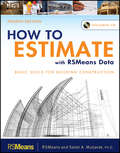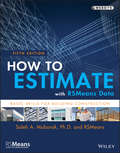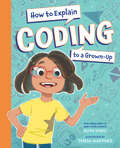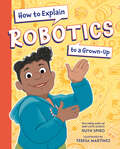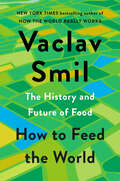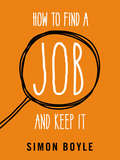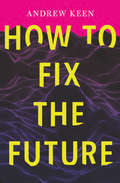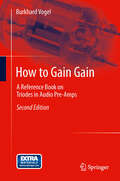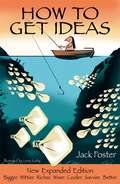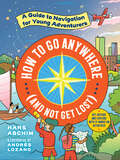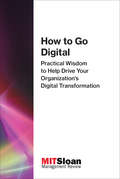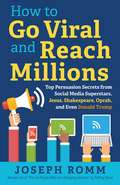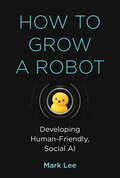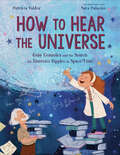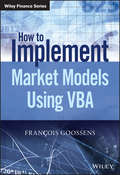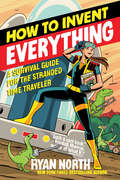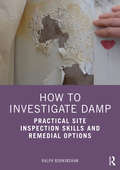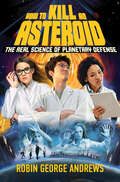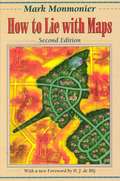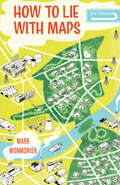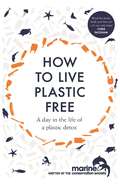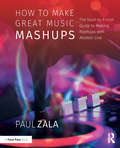- Table View
- List View
How to Estimate with RSMeans Data
by Saleh A. MubarakUsing North America's most recognized construction cost data from RSMeans, this step-by-step guide develops problem-solving skills through over 300 sample problems and exercises. All of the major construction items, including site work, concrete and masonry, wood and metal framing, doors and windows, and more are covered. Access to a password-protected web site is included, which contains the instruction version of RSMeans Cos/Works, the electronic version of RS Means Building Construction Cost Data, and sample building plans and spreadsheets, enabling you to practice creating a complete construction estimate.
How to Estimate with RSMeans Data: Basic Skills for Building Construction (RSMeans #64)
by Saleh A. Mubarak RSMeansA practical, hands-on guide to real-world construction estimating How to Estimate with RSMeans Data is the only instructional book on construction cost estimating that uses the most popular source of construction cost data, RS Means. This updated fifth edition includes new coverage on the role of Building Information Modeling (BIM) in the estimating process, and over 300 sample problems and exercises that show you how to apply cost data to your building project based on the RS Means 2015 Building Construction Cost Data. The companion website provides access to RS Means CostWorks data, allowing you to use real-world numbers in your practice estimates, and the included Instructor's Manual provides step-by-step solutions to problems in the book. Focused on the practical aspects of estimating, this book emphasizes the application of estimating techniques—which are transferable to any estimating software—through problem solving and the ground-up creation of complete construction project estimates. Estimating skills are fundamental to the construction industry, and are applied by all parties at all levels throughout the industry. This book is a hands-on guide to the techniques and tools used to create a thorough estimate, with plenty of opportunities for practice. Apply cost data to all aspects of the building project Practice your skills on over 300 sample problems Construct a complete estimate using RSMeans Besides being an essential construction skill, learning estimating helps you become familiar with reading and understanding construction blueprints and how construction assemblies are built. Mastery of these vital skills is important to your future career, and How to Estimate with RSMeans Data is your ideal guide to a solid foundation.
How to Explain Coding to a Grown-Up (How to Explain Science)
by Ruth SpiroThe best-selling author of the Baby Loves Science series levels up with this playful STEM picture book introducing kids–and grown-ups–to the coding world.Grown-ups do NOT have all the answers! In this tongue-in-cheek guide, an in-the-know narrator instructs perceptive kid readers in the fine art of explaining coding to a grown-up. Both children and their adults learn the basics of coding, including hardware, software, algorithms, and debugging. Cleverly disguised &“pro tips&” suggest best practices for teaching any topic.Fun and fact-filled, the How to Explain Science series will empower kid experts to explore complex scientific concepts with any grown-up who will listen.
How to Explain Robotics to a Grown-Up
by Ruth SpiroThe best-selling author of the Baby Loves Science series levels up with this playful STEM picture book introducing kids–and grown-ups–to the robotics world.Do you want to know a secret? Sometimes grown-ups need YOU to explain things to THEM. Like robotics!In this tongue-in-cheek guide, an in-the-know narrator instructs kid readers in the fine art of explaining robotics to a grown-up. Both children and their adults learn:what makes a robot a robot, who designs and builds robots, and how robots work on their own to get a job done. Fun and fact-filled, the How to Explain Science series will empower kid experts to explore complex scientific concepts with any grown-up who will listen.
How to Feed the World: The History and Future of Food
by Vaclav Smil"Vaclav Smil is my favorite author."—Bill GatesAn indispensable analysis of how the world really produces and consumes its food—and a scientist's exploration of how we can successfully feed a growing population without killing the planetWe have never had to feed as many people as we do today. And yet, we misunderstand the essentials of where our food really comes from, how our dietary requirements shape us, and why this impacts our planet in drastic ways. As a result, in our economic, political, and everyday choices, we take for granted and fail to prioritize the thing that makes all our lives possible: food.In this ambitious, myth-busting book, Smil investigates many of the burning questions facing the world today: why are some of the world&’s biggest food producers also the countries with the most undernourished populations? Why do we waste so much food and how can we solve that? Could the whole planet go vegan and be healthy? Should it? He explores the global history of food production to understand why we farm some animals and not others, why most of the world&’s calories come from just a few foodstuffs, and how this might change in the future.How to Feed the World is the data-based, rigorously researched guide that offers solutions to our broken global food system.
How to Find a Job and Keep It
by Simon BoyleLooking for a job? Don’t know where to start? This friendly book is here to help you. Learn how to:· Write a CV and covering letter· Contact employers and recruitment agencies· Manage your personal finances· Act professionally in a work environment And most important of all:· Find a job you love, and keep it! So why not open it now and get going?
How to Fix the Future: Staying Human In The Digital Age (Books That Changed the World)
by Andrew KeenFrom data breaches to disinformation,a look at the digital revolution’s collateral damage with “practical solutions to a wide-range of tech-related woes” (TechCrunch).In this book, a Silicon Valley veteran travels around the world and interviews important decision-makers to paint a picture of how tech has changed our lives—for better and for worse—and what steps we might take, as societies and individuals, to make the future something we can once again look forward to.“A truly important book and the most significant work so far in an emerging body of literature in which technology’s smartest thinkers are raising alarm bells about the state of the Internet, and laying groundwork for how to fix it.”?Fortune“After years of giddiness about the wonders of technology, a new realization is dawning: the future is broken. Andrew Keen was among the first and most insightful to see it. The combination of the digital revolution, global hyperconnectivity, and economic dysfunction has led to a populist backlash and destruction of civil discourse. In this bracing book, Keen offers tools for righting our societies and principles to guide us in the future.”?Walter Isaacson, New York Times-bestselling author of Steve Jobs and Leonardo Da Vinci“Comparing our current situation to the Industrial Revolution, he stresses the importance of keeping humanity at the center of technology.”?Booklist“Valuable insights on preserving our humanity in a digital world.”?Kirkus Reviews (starred review)
How to Gain Gain
by Burkhard VogelThe 34 chapters of the 2nd edition of How to Gain Gain give a detailed insight into a collection (54) of the most common gain producing, constant current generating possibilities, and electronic noise creation of triodes for audio pre-amplifier purposes. These chapters also offer complete sets of formulae to calculate gain, frequency and phase responses, and signal-to-noise ratios of certain building blocks built-up with this type of vacuum valve (tube). In all cases detailed derivations of the gain formulae are also presented. All what is needed are the data sheet valve characteristic figures of the triode's mutual conductance, the gain factor and the internal plate (anode) resistance. To calculate frequency and phase responses of gain stages the different data sheet based input and output capacitances have to be taken into account too. To calculate transfer functions and signal-to-noise ratios for any kind of triode driven gain stage, including all its bias setting, frequency, phase, and electronic noise influencing components, example Mathcad 11 worksheets as an essential simulation tool for each chapter allow easy follow-up and application of the respective formulae. Free download of all worksheets is guaranteed from the editor's web-site.
How to Get Ideas
by Jack Foster Larry CorbyThis new expanded second edition is an international bestseller with over 200,000 copies sold and translated into 15 languages that shows you—no matter your age or skill, your job or training—how to come up with more ideas, faster and easier. Jack Foster's simple five-step technique for solving problems and getting ideas takes the mystery and anxiety out of the idea-generating process. It's a proven process that works. You'll learn to condition your mind to become "idea-prone," utilize your sense of humor, develop your curiosity, visualize your goals, rethink your thinking, and overcome your fear of rejection. This expanded edition of the inspiring and enlightening classic features new information on how to turn failures to your advantage and how to create a rich, idea-inducing environment. Dozens of new examples and real life stories show that anyone can learn to get more and better ideas.
How to Go Anywhere (and Not Get Lost): A Guide to Navigation for Young Adventurers
by Hans AschimBorn to explore Get outside with this interactive book that shows how explorers have found their way around the planet for thousands of years. Read about the ancient Polynesians who tracked the stars and waves to sail precise paths through the ocean. Or the Age of European Exploration navigators who use compasses and dead reckoning to reach the New World. And learn the science behind radar and modern-day GPS satellites. Then discover how to do it yourself! With illustrated activities as well as handy tips throughout, you&’ll learn the fascinating history and seriously useful skills to become a true navigator. Up your adventure game and learn to: —Find north and south by reading the trees —Make a simple compass —Use the stars to tell time —Build a basic sextant —Get your bearings using the sun —Go treasure hunting with GPS
How to Go Digital: Practical Wisdom to Help Drive Your Organization's Digital Transformation (The Digital Future of Management)
by MIT Sloan Management ReviewAdvice on how companies can succeed in the new digital business environment.The most important skills a leader needs to succeed in a digital environment are not technical in nature but managerial—strategic vision, forward-looking perspective, change-oriented mindset. A company's digital transformation does not involve abandoning widget-making for app developing or pursuing “disruption” at the cost of stability. Rather, it is about adopting business processes and practices that position organizations to compete effectively in the digital environment. More important than technology implementation are strategy, talent management, organizational structure, and leadership aligned for the digital world. How to Go Digital offers advice from management experts on how to steer your company into the digital future.The book will put you on the right strategic path, with articles from MIT Sloan Management Review on developing a digital strategy, reframing growth for a digital world, monetizing data, and generating sustainable value from social media. Talent acquisition and retention are addressed, with articles on HR analytics, data translators, and enabling employees to become brand ambassadors outside of the office. Operational makeovers are discussed in terms of sales, services, new technologies, and innovation.ContributorsAllan Alter, Stephen J. Andriole, Bart Baesens, Gloria Barczak, Cynthia M. Beath, Alpheus Bingham, Didier Bonnet, Chris Brady, Joseph Byrum, Marina Candi, Manuel Cebrian, Marie-Cécile Cervellon, Simon Chadwick, Sophie De Winne, Mike Forde, Gerald C. Kane, Rahul Kapoor, David Kiron, Thomas Klueter, Mary C. Lacity, Rikard Lindgren, Pamela Lirio, Tucker J. Marion, Lars Mathiassen, Pete Maulik, Paul Michelman, Narendra Mulani, Pierre Nanterme, Doug Palmer, Alex “Sandy” Pentland, Anh Nguyen Phillips, Frank T. Piller, Iyad Rahwan, Deborah L. Roberts, Jeanne W. Ross, Ina M. Sebastian, Luc Sels, James E. Short, Fredrik Svahn, Steve Todd, Leslie P. Willcocks, H. James Wilson, Barbara H. Wixom
How to Go Viral and Reach Millions: Top Persuasion Secrets from Social Media Superstars, Jesus, Shakespeare, Oprah, and Even Donald Trump
by Joseph RommHow to Go Viral and Reach Millions is the first book to reveal all the latest secrets for consistently generating viral online content-words, images, or videos that are seen and shared by hundreds of thousands and eventually even millions of people, something Romm and his colleagues in three different organizations achieve routinely.
How to Grow a Robot: Developing Human-Friendly, Social AI
by Mark H. LeeHow to develop robots that will be more like humans and less like computers, more social than machine-like, and more playful and less programmed.Most robots are not very friendly. They vacuum the rug, mow the lawn, dispose of bombs, even perform surgery—but they aren't good conversationalists. It's difficult to make eye contact. If the future promises more human-robot collaboration in both work and play, wouldn't it be better if the robots were less mechanical and more social? In How to Grow a Robot, Mark Lee explores how robots can be more human-like, friendly, and engaging.Developments in artificial intelligence—notably Deep Learning—are widely seen as the foundation on which our robot future will be built. These advances have already brought us self-driving cars and chess match–winning algorithms. But, Lee writes, we need robots that are perceptive, animated, and responsive—more like humans and less like computers, more social than machine-like, and more playful and less programmed. The way to achieve this, he argues, is to “grow” a robot so that it learns from experience—just as infants do. After describing “what's wrong with artificial intelligence” (one key shortcoming: it's not embodied), Lee presents a different approach to building human-like robots: developmental robotics, inspired by developmental psychology and its accounts of early infant behavior. He describes his own experiments with the iCub humanoid robot and its development from newborn helplessness to ability levels equal to a nine-month-old, explaining how the iCub learns from its own experiences. AI robots are designed to know humans as objects; developmental robots will learn empathy. Developmental robots, with an internal model of “self,” will be better interactive partners with humans. That is the kind of future technology we should work toward.
How to Hear the Universe: Gaby González and the Search for Einstein's Ripples in Space-Time
by Patricia ValdezDiscover new realms of outer space in this picture book biography of scientist Gabriela Gonzalez, who immigrated to America and became a ground-breaking scientist. Written by a molecular biologist and illustrated by an award-winning artist, this stunning picture book explores science, space, and history.In 1916, Albert Einstein had a theory. He thought that somewhere out in the universe, there were collisions in space. These collisions could cause little sound waves in the fabric of space-time that might carry many secrets of the distant universe. But it was only a theory. He could not prove it in his lifetime.Many years later, an immigrant scientist named Gabriela Gonzalez asked the same questions. Armed with modern technology, she joined a team of physicists who set out to prove Einstein's theory. At first, there was nothing. But then... they heard a sound. Gabriela and her team examined, and measured, and re-measured until they were sure. Completing the work that Albert Einstein had begun 100 years earlier, Gonzalez broke ground for new space-time research. In a fascinating picture book that covers 100 years, 2 pioneering scientists, and 1 trailblazing discovery, Patricia Valdez sheds light on a little known but extraordinary story.
How to Implement Market Models Using VBA
by Francois GoossensAccessible VBA coding for complex financial modelling How to Implement Market Models Using VBA makes solving complex valuation issues accessible to any financial professional with a taste for mathematics. With a focus on the clarity of code, this practical introductory guide includes chapters on VBA fundamentals and essential mathematical techniques, helping readers master the numerical methods to build an algorithm that can be used in a wide range of pricing problems. Coverage includes general algorithms, vanilla instruments, multi-asset instruments, yield curve models, interest rate exotics, and more, guiding readers thoroughly through pricing in the capital markets area. The companion website (http://implementmodinvba.com/) features additional VBA code and algorithmic techniques, and the interactive blog provides a forum for discussion of code with programmers and financial engineers, giving readers insight into the different applications and customisations possible for even more advanced problem solving.. Financial engineers implement models from a mathematical representation of an asset's performance by building a program that performs a valuation of securities based on this asset. How to Implement Market Models Using VBA makes this technical process understandable, with well-explained algorithms, VBA code, and accessible theoretical explanations. Decide which numerical method to use in which scenario Identify the necessary building blocks of an algorithm. Write clear, functional VBA code for a variety of problems. Apply algorithms to different instruments and models . Designed for finance professionals, this book brings more accurate modelling within reach for anyone with interest in the market. For clearer code, patient explanation, and practical instruction, How to Implement Market Models Using VBA is an essential introductory guide.
How to Invent Everything: A Survival Guide for the Stranded Time Traveler
by Ryan North"How to Invent Everything is such a cool book. It's essential reading for anyone who needs to duplicate an industrial civilization quickly." --Randall Munroe, xkcd creator and New York Times-bestselling author of What If? The only book you need if you're going back in timeWhat would you do if a time machine hurled you thousands of years into the past. . . and then broke? How would you survive? Could you improve on humanity's original timeline? And how hard would it be to domesticate a giant wombat? With this book as your guide, you'll survive--and thrive--in any period in Earth's history. Bestselling author and time-travel enthusiast Ryan North shows you how to invent all the modern conveniences we take for granted--from first principles. This illustrated manual contains all the science, engineering, art, philosophy, facts, and figures required for even the most clueless time traveler to build a civilization from the ground up. Deeply researched, irreverent, and significantly more fun than being eaten by a saber-toothed tiger, How to Invent Everything will make you smarter, more competent, and completely prepared to become the most important and influential person ever. You're about to make history. . . better.
How to Investigate Damp: Practical Site Inspection Skills and Remedial Options
by Ralph BurkinshawThe aim of this book is to take the reader by the hand and show them exactly how to carry out various inspection techniques to identify the causes of damp in buildings. This is achieved by taking them through a variety of investigation methods using real-life case studies illustrated by dozens of sketches, drawings and photographs – and considerable insight into how investigations can be conducted on site – and also including most importantly the Client’s input and perspective on a damp issue. Written in non-technical language by a leading expert and author on damp, the book begins by outlining the common types and phases of an investigation, the equipment required and the nature of potential remedial work. Case studies then cover condensation, penetrating damp, plumbing and roof leaks, below ground moisture and flooding – and less common causes such as residual construction moisture. The final section contains step by step guidance on procedures such as using a humidity box, inspecting a cavity wall, using a damp meter and extracting and testing a plaster sample for salt content. The book is full of hints and tips developed over a career spent investigating, diagnosing and remediating damp issues and is essential reading for surveyors looking to improve their skills and knowledge of this often complex defect. The book will also be very useful for homeowners trying to self-diagnose, and architects, engineers and other professionals who need to gain insight into common problems caused by moisture imbalance in buildings.
How to Kill an Asteroid: The Real Science of Planetary Defense
by Robin George AndrewsA gripping account of the “city-killer” asteroids that could threaten Earth and the race to build a planetary defense system. There are approximately 25,000 “city killer” asteroids in near-Earth orbit—and most are yet to be found. Small enough to evade detection, they are capable of large-scale destruction, and represent our greatest cosmic threat. But in September 2022, against all odds, NASA’s Double Asteroid Redirection Test (DART) mission deliberately crashed a spacecraft into a carefully selected city killer, altering the asteroid’s orbit and proving that we stand a chance against them. In How to Kill an Asteroid, award-winning science journalist Robin George Andrews—who was at DART mission control when it happened—reveals the development of the technology that made it possible, from spotting elusive asteroids and comets to figuring out their geologic defenses and orchestrating a deflection campaign. In a propulsive narrative that reads like a sci-fi thriller, Andrews tells the story of the planetary defense movement, and introduces the international team of scientists and engineers now working to protect Earth.
How to Lie with Maps 2nd Edition
by Mark MonmonierOriginally published to wide acclaim, this lively, cleverly illustrated essay on the use and abuse of maps teaches us how to evaluate maps critically and promotes a healthy skepticism about these easy-to-manipulate models of reality. Monmonier shows that, despite their immense value, maps lie. In fact, they must.
How to Lie with Maps, Third Edition
by Mark MonmonierAn instant classic when first published in 1991, How to Lie with Maps revealed how the choices mapmakers make—consciously or unconsciously—mean that every map inevitably presents only one of many possible stories about the places it depicts. The principles Mark Monmonier outlined back then remain true today, despite significant technological changes in the making and use of maps. The introduction and spread of digital maps and mapping software, however, have added new wrinkles to the ever-evolving landscape of modern mapmaking. Fully updated for the digital age, this new edition of How to Lie with Maps examines the myriad ways that technology offers new opportunities for cartographic mischief, deception, and propaganda. While retaining the same brevity, range, and humor as its predecessors, this third edition includes significant updates throughout as well as new chapters on image maps, prohibitive cartography, and online maps. It also includes an expanded section of color images and an updated list of sources for further reading.
How to Lie with Maps: Second Edition
by Mark MonmonierOriginally published to wide acclaim, this lively, cleverly illustrated essay on the use and abuse of maps teaches us how to evaluate maps critically and promotes a healthy skepticism about these easy-to-manipulate models of reality. Monmonier shows that, despite their immense value, maps lie. In fact, they must. The second edition is updated with the addition of two new chapters, 10 color plates, and a new foreword by renowned geographer H. J. de Blij. One new chapter examines the role of national interest and cultural values in national mapping organizations, including the United States Geological Survey, while the other explores the new breed of multimedia, computer-based maps. To show how maps distort, Monmonier introduces basic principles of mapmaking, gives entertaining examples of the misuse of maps in situations from zoning disputes to census reports, and covers all the typical kinds of distortions from deliberate oversimplifications to the misleading use of color. "Professor Monmonier himself knows how to gain our attention; it is not in fact the lies in maps but their truth, if always approximate and incomplete, that he wants us to admire and use, even to draw for ourselves on the facile screen. His is an artful and funny book, which like any good map, packs plenty in little space. " "Scientific American" "A useful guide to a subject most people probably take too much for granted. It shows how map makers translate abstract data into eye-catching cartograms, as they are called. It combats cartographic illiteracy. It fights cartophobia. It may even teach you to find your way. For that alone, it seems worthwhile. " Christopher Lehmann-Haupt, "The New York Times" . " . . witty examination of how and why maps lie. The book] conveys an important message about how statistics of any kind can be manipulated. But it also communicates much of the challenge, aesthetic appeal, and sheer fun of maps. Even those who hated geography in grammar school might well find a new enthusiasm for the subject after reading Monmonier's lively and surprising book. " "Wilson Library Bulletin" "A reading of this book will leave you much better defended against cheap atlases, shoddy journalism, unscrupulous advertisers, predatory special-interest groups, and others who may use or abuse maps at your expense. " John Van Pelt, "Christian Science Monitor" "Monmonier meets his goal admirably. . . . His] book should be put on every map user's 'must read' list. It is informative and readable . . . a big step forward in helping us to understand how maps can mislead their readers. " Jeffrey S. Murray, "Canadian Geographic""
How to Live Plastic Free: a day in the life of a plastic detox
by Luca BonaccorsiThank you for choosing this book - it shows that you care about the future of our planet.Whether you decide to go plastic free for an hour, a day or a year, this book will equip you with little steps we can each take to make a big difference.Let's turn the tide on plastic now - our oceans will thank you for it.Choking. Starving. Poisoning. This is what plastic litter is doing to marine life. Our oceans are, quite simply, facing environmental disaster. Yet by taking some simple steps and making a few changes to your daily routine, you can help to change this.How to Live Plastic Free will teach you everything you need to know about reducing your plastic usage on a daily basis. The chapters start with a typical morning routine and take you through your day, giving you tips and practical advice for removing unnecessary plastic at every possible opportunity.From the moment you wake up to the time you go to bed, you will learn how easy it can be to use plastic-free cosmetics, how to have plastic-free mealtimes, how to change your shopping habits and how to consider your use of plastic items at work. These simple, practical methods will show that small changes to your lifestyle can make a huge change to the future of our planet.
How to Live Plastic Free: a day in the life of a plastic detox
by Luca Bonaccorsi Marine Conservation SocietyThank you for choosing this book - it shows that you care about the future of our planet.Whether you decide to go plastic free for an hour, a day or a year, this book will equip you with little steps we can each take to make a big difference.Let's turn the tide on plastic now - our oceans will thank you for it.Choking. Starving. Poisoning. This is what plastic litter is doing to marine life. Our oceans are, quite simply, facing environmental disaster. Yet by taking some simple steps and making a few changes to your daily routine, you can help to change this.How to Live Plastic Free will teach you everything you need to know about reducing your plastic usage on a daily basis. The chapters start with a typical morning routine and take you through your day, giving you tips and practical advice for removing unnecessary plastic at every possible opportunity.From the moment you wake up to the time you go to bed, you will learn how easy it can be to use plastic-free cosmetics, how to have plastic-free mealtimes, how to change your shopping habits and how to consider your use of plastic items at work. These simple, practical methods will show that small changes to your lifestyle can make a huge change to the future of our planet.
How to Live Plastic Free: a day in the life of a plastic detox
by Luca Bonaccorsi Marine Conservation SocietyThank you for choosing this book - it shows that you care about the future of our planet.Whether you decide to go plastic free for an hour, a day or a year, this book will equip you with little steps we can each take to make a big difference.Let's turn the tide on plastic now - our oceans will thank you for it.Choking. Starving. Poisoning. This is what plastic litter is doing to marine life. Our oceans are, quite simply, facing environmental disaster. Yet by taking some simple steps and making a few changes to your daily routine, YOU can help to change this.How to Live Plastic Free will teach you everything you need to know about reducing your plastic usage on a daily basis. The chapters start with a typical morning routine and take you through your day, giving you tips and practical advice for removing unnecessary plastic at every possible opportunity.From the moment you wake up to the time you go to bed, you will learn how easy it can be to use plastic-free cosmetics, how to have plastic-free mealtimes, how to change your shopping habits and how to consider your use of plastic items at work. These simple, practical methods will show that small changes to your lifestyle can make a huge change to the future of our planet.#StopThePlasticTide
How to Make Great Music Mashups: The Start-to-Finish Guide to Making Mashups with Ableton Live
by Paul ZalaWritten for the beginner DJ, this accessible book presents everything you need to know in order to create great dance floor moments that will take your sets to the next level and get you noticed as a DJ. Using Ableton’s industry-leading digital audio workstation, the reader will learn to achieve a professional sound by expertly manipulating Warping, pitching, editing, automation and plugin effects processing; also, avoiding mistakes such as key-clashing, jarring transitions, mismatched energies and more. The book’s companion website includes key-charts, musical scale diagrams, organisational templates for live sessions, and follow-along video demonstrations.
